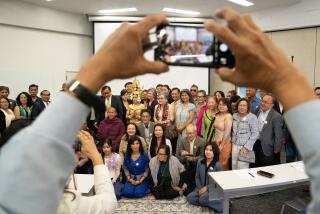Peace Treaty Signed to End Cambodia War
PARIS â Representatives of 19 nations, including the United States, signed an international peace agreement on Wednesday, ending 21 years of conflict in Cambodia and placing the Southeast Asian country under U.N. administration until general elections can be held in 1993.
The assignment, with a cost estimated at $2 billion, is the biggest, most expensive ever for the United Nations.
Under the agreement, U.N. officials and blue-beret military forces will be responsible for monitoring a cease-fire, disarming the population, removing mines from the countryside, repatriating refugees and assuming direct administration of the countryâs bureaucracy.
The U.N. Transitional Authority in Cambodia will be asked to register voters and conduct elections for a constituent assembly that is to eventually evolve into a national parliament.
U.N. officials will be advised during the process by a Supreme National Council headed by Prince Norodom Sihanouk, the former monarch who ruled Cambodia from 1953 until he was ousted by a U.S.-backed coup in 1970.
Speaking in support of the peace treaty Wednesday, Secretary of State James A. Baker III said it marks âthe prospect of a new era in Southeast Asia.â He said the United States hopes to use the treaty as a basis for renewing ânormal relations with all the states of Indochina.â
âWe have communicated these intentions to the governments of Vietnam, Laos and Cambodia,â Baker said.
In an emotional speech to the delegates at the Kleber International Center in Paris, Sihanouk, 70, his thinning hair white at the temples, somberly accepted the role as healer for his country after years of bloody conflict that cost the lives of more than 1 million Cambodians.
But sitting only two seats to his left was Khieu Samphan, the representative of the Khmer Rouge political movement founded by former Cambodian dictator Pol Pot.
Between April, 1975, when it defeated U.S.-backed government forces in Cambodia, and early January, 1979, when it fell to invading Vietnamese forces, the Khmer Rouge conducted a reign of genocidal terror that left hundreds of thousands dead.
Although the Khmer Rouge has claimed recently to have embraced democracy and endorsed free-market economics, its presence on the Supreme National Council has been widely cited as the main flaw of the peace agreement, the result of four years of negotiations jointly sponsored by France and Indonesia.
Human rights organizations have warned of a Khmer Rouge secret agenda to take over the country by posing as a legitimate political party.
Khmer Rouge troops on the Thailand-Cambodia border have been accused of attempting to force many of the 350,000 refugees living in U.S.-supervised camps back into Khmer Rouge-controlled territory.
Military experts say the estimated 30,000 Khmer Rouge soldiers, the most potent single military force in the land, have shown little interest in turning over their large caches of Chinese-supplied weapons.
Under the peace agreement, U.N. forces are assigned to disarm 70% of all fighting forces in Cambodia and restrict the other 30% in supervised camps.
Western diplomats attending the treaty-signing ceremony asked critics to be realistic about its contents and the role played by the Khmer Rouge. âThis was the least bad of all possible solutions,â said one diplomat.
Officials expect an immediate economic boost for the impoverished Cambodians, partly from the money the United Nations is expected to spend in the country and partly because the United States and other countries have promised to lift economic sanctions against Cambodia because of the treaty.
âWe are prepared to normalize U.S. economic relations with Cambodia,â Baker said Wednesday. He said that once U.N. administrators and military forces are in place, âwe will lift our trade embargo toward Cambodia and begin supporting projects in the country by international lending institutions such as the World Bank.â
The Japanese government has also pledged substantial aid and economic development programs in Cambodia.
Baker said the United States will soon establish a liaision office in Phnom Penh, the Cambodian capital.
According to reports from the region by the French newspaper Le Monde, teams of carpenters and masons, mostly from Vietnam, have already begun work in Phnom Penh to renovate villas for use by U.N. and foreign diplomatic missions. In a city where most residents are too poor to buy electricity for lighting, Le Monde reported that the villas would be leased for $3,000 to $4,000 a month.
The peace treaty, printed in English, French, Khmer, Russian and Chinese, was signed at 7:22 p.m. Paris time.
In his opening remarks for the conference, French President Francois Mitterrand said the treaty marks the turning of âa dark page in the history of a country.â Like other Western leaders, Mitterrand lavishly praised Sihanouk as the embodiment of hope for the revived country.
âHis return to Phnom Penh next month,â Mitterrand said of Sihanouk, âwill be the symbol of the renaissance of Cambodia and of the reconciliation of all the Cambodians.â
At the basic level, the treaty marks the reconciliation of the main political forces in Cambodia, the Vietnam- and Soviet-backed regime under Premier Hun Sen and the three-party opposition coalition, headed by Prince Sihanouk, that includes the Khmer Rouge.
But on the global scale, it is the latest example of an emerging post-Cold War order.
Under Cold War geopolitics, Cambodia was a classic example of different powers backing rival sides in conflict as part of a broader international strategy. The Khmer Rouge, for example, enjoyed Chinaâs support. Western powers backed Sihanouk and the other non-Communist opposition party. The Communist regime in Phnom Penh was backed by Vietnam and the Soviet Union.
Conciliation in Cambodia
THE PAST
* Attacked by Thais and Vietnamese since 15th Century.
* Saved from its neighbors by French intervention in 1863.
* Became independent kingdom in 1953 under Norodom Sihanouk.
* Sihanouk overthrown by U.S.-backed coup in 1970 and Gen. Lon Nol proclaimed Khmer Republic.
* Phnom Penh fell to Khmer Rouge Communists in 1975.
* Khmer Rouge forces raided Vietnam, prompting retaliation in 1978. Government of Premier Pol Pot toppled in January, 1979.
* Khmer Rouge and Khmer Peopleâs National Liberation Front formed Coalition Government of Democratic Kampuchea with Sihanouk as president in June, 1982.
THE FUTURE
Following are key points of peace treaty:
* U.N. Transitional Authority in Cambodia, known as UNTAC, will control cease-fire, demobilize and disarm 70% of fighting forces and restrict remaining 30% to U.N.-supervised zones.
* UNTAC will register voters, control electoral campaign and conduct free elections for constituent assembly.
* During transition period, Supreme National Council (made up of four warring factions) will embody Cambodian sovereignty, advise UNTAC and represent nation at international forums like United Nations.
More to Read
Sign up for Essential California
The most important California stories and recommendations in your inbox every morning.
You may occasionally receive promotional content from the Los Angeles Times.










